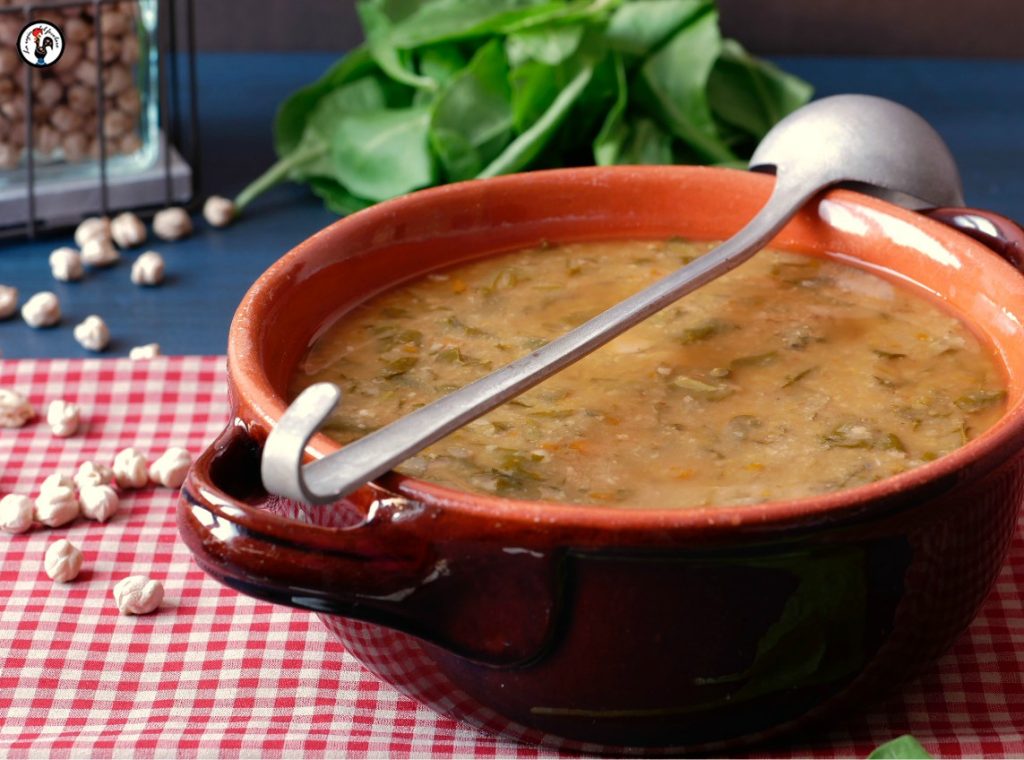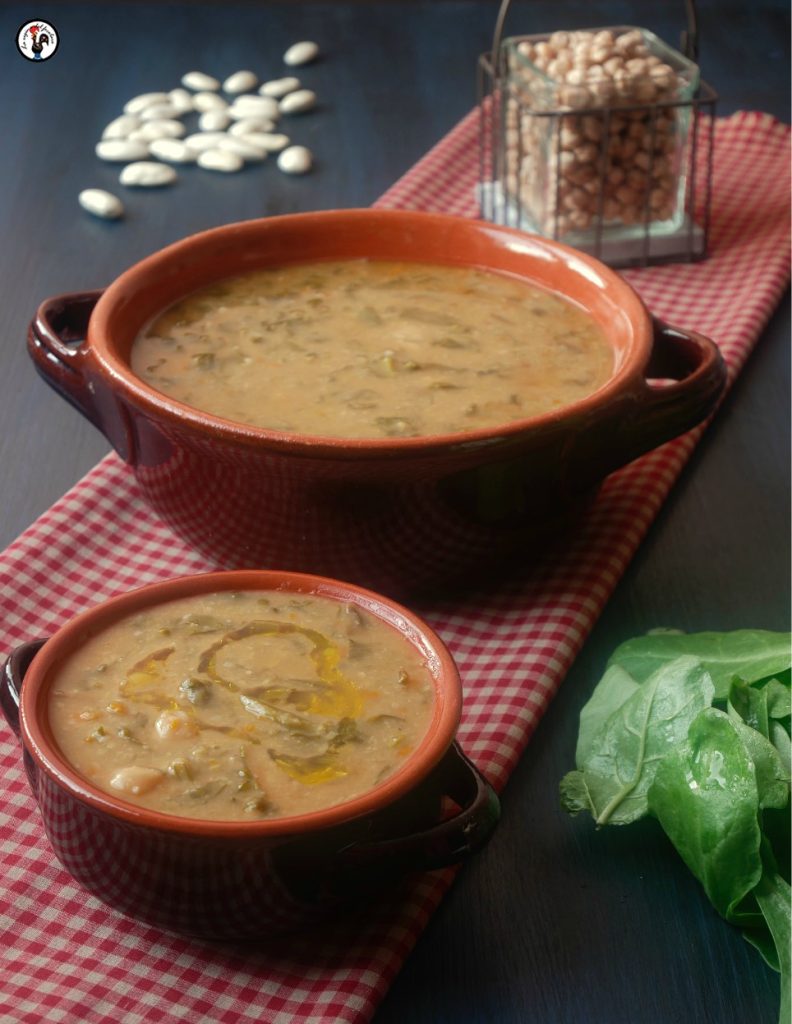The chickpea and Swiss chard zimino is the traditional Genoese recipe for All Souls’ Day. A thick soup, almost a stew that is prepared the day before. The dried legumes need to be soaked overnight and cooked slowly for a long time. In the Genoese zemin of chickpeas (as it is called in Genoa) there are giant chickpeas and large white beans, then thinly sliced Swiss chard sauteed in a pan with all the flavors and some dried mushrooms. The soup is simmered all together to become well-flavored, then it rests for a few hours. Also, to make a proper chickpea zimino, the large white beans are peeled before cooking, so that they can break down and give consistency to this soup, one of the most ancient traditional Genoese recipes. So, while everyone is cooking scary sweets for Halloween, I, a vintage but nonconformist cook, prepare the zemin, calmly. I delve into family memories and among dear faces that come to mind thanks to the simple, careful gestures needed to prepare it. I’ll tell you about it today, a bit in advance, to give you time to buy the ingredients. Below you will find:
• Ingredients
• Preparation
• Cooking
• The Queen’s secrets – Genoese notes and curiosities
If you are looking for more traditional Genoese recipes for All Souls’ Day also read:

- Difficulty: Easy
- Cost: Economical
- Rest time: 12 Hours
- Preparation time: 15 Minutes
- Portions: 4
- Cooking methods: Stove
- Cuisine: Italian Regional
Ingredients for chickpea zimino
- 8.82 oz large white beans (dried (variety Bianchi di Spagna))
- 8.82 oz chickpeas (dried)
- 7.05 oz Swiss chard (leaves only, no stems)
- 0.18 oz dried mushrooms
- Half yellow onion
- Half carrot
- Half stalk celery
- 3 tbsps extra virgin olive oil
- 1 leaf bay leaf
- 1 sprig rosemary
- 0.35 oz tomato paste
- to taste salt
- 1 pinch black pepper
How to prepare chickpea and Swiss chard zimino
Soak the legumes in fresh water in two separate bowls and let them soak for at least 12 hours. It’s usually done in the evening to have the legumes ready the next morning. Carefully peel the large white beans. Typical beans from Liguria and Southern Piedmont, large white beans are big and white, with a thick skin: they won’t require much effort. Then boil the legumes in plenty of clean water, with a bay leaf and a well-tied rosemary sprig. Cook them, without salt and on low heat, for at least two hours. The peeled large white beans will cook faster than the chickpeas, so taste the latter before turning off the heat. I always add Kombu seaweed to the cooking legumes. It helps soften the skin and aids digestion.
Take a bunch of fresh Swiss charde, wash them carefully, and cut them very thin (this is not a detail, because if they are not cut small, they will be bothersome in the mouth). Chop onion, celery, and carrot, add the dried mushrooms, and put them in a pan with oil and two tablespoons of water. When the sauté is ready, add the chard and let them cook for about ten minutes. Adjust salt and pepper, and when the vegetables are ready and flavored, turn off the heat.

Now take the food mill and pass half of the legumes into a large earthenware pot. Use a slotted spoon to drain the others, sauté them in a pan with the Swiss chard and sauté and let flavor for a few minutes over high heat (be careful not to burn!). Then transfer everything into the earthenware pot and gradually add the cooking water needed to reach the right consistency. Now turn on the low heat again, add the necessary salt, tomato paste, and let the zemin cook for another hour, with the lid on. Be sure not to discard the remaining water: it might still be needed.
This soup is eaten on its own, with croutons, or (if you wish, but we never do) with minestrone pasta.
The Queen’s Secrets – Genoese Notes, Curiosities, and Recipes
A few words about Kombu seaweed: it really works and aids the digestion of legumes. You’ll easily find it in herbalists or organic supermarkets. I go to Via dei Macelli di Soziglia, at theLa Pulsatilla Herbalist, where I always find what I’m looking for. The girls are knowledgeable, friendly, and kind: highly recommended for those living in Genoa.
While everyone is cooking monster recipes, I dedicate myself to comfort food and prepare the ancient chickpea zimino. If someone knocks on my door on All Souls’ Night, I will have a bowl of steaming soup ready, as was done long ago in Liguria at the Ben dei morti.
• Stockfish with Fava Beans – The Traditional Recipe
• Fava Beans of the Dead – Genoese Almond Paste Sweets
Also, I wrote a short article, telling something about Ligurian traditions and popular customs for All Saints’ and All Souls’ Day.
If you like hearty soups, don’t miss
• Ribollita – Country Soup, you’ll discover by reading it that it’s a fairytale recipe…
Do you know where to find me?
Ligurian cuisine is simple, dishes with few, often humble ingredients. But it is delicious. Try the Genoese Minestrone, the focaccia, and the pesto. If you want to read all my Genoese recipes, and much more, RETURN TO THE HOME. And also follow me on Facebook, where we can chat endlessly. Leave a comment, below you will find the space to do so. I will be happy to read it.
Starting today, you can receive all new recipes on the Telegram channel of my blog. It is free, and to subscribe, you just need to open this link: in this way, you will always be updated on recipes, secrets, advice, and news. You can receive all the recipes on your phone without risking missing any and without needing to enter any phone number or email address; if you then wish to leave the channel, you just have to delete it.

